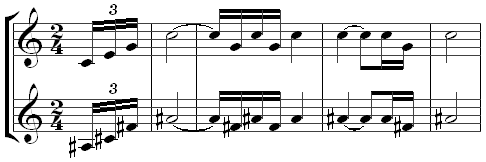Polytonality
|
|
The use of more than two keys simultaneously is known in music as polytonality. Bitonality is the use of only two different keys at the same time. While initially polytonality referred to simply to "contrapuntally juxtaposed tonalities" it quickly was applied to any "simultaneous tonalities...that cross, overlap, complement or even oppose each other." (Reti, 1958)
A well known example is the fanfare at the beginning of Igor Stravinsky's ballet, Petrushka. The first clarinet plays a melody in C major, while the second clarinet plays nearly the same melody in F sharp major:
K522_multitonality.PNG
Although this example consists of just two melodic lines, some examples of bitonality contrast fully harmonised sections of music in different keys. Examples of this rather more dissonant kind of bitonality can be found in the work of Charles Ives, whose use of the technique in later additions (1909-1910) to his Variations on "America" (1891) is one of the first in classical music. Earlier examples, such as Wolfgang Amadeus Mozart's Ein musikalischer Spass, tend to use the technique for comic effect.
Debussy's works often employ nascent polytonality (Reti, 1958). Bitonality was used quite often by members of the French group, Les Six, and especially by Darius Milhaud, who perhaps used it more than any other composer. Many composers today who are interested in using tonality are also interested in bitonality, such as Philip Glass in his Symphony No. 2.
Although the word bitonality is most often used when talking about relatively modern classical music (written in the last one hundred years or so), it is quite a common technique in folk music, especially in eastern Europe.
Milton Babbitt, Paul Hindemith, and other theorists have "questioned and even dismissed as a viable auditory possibility," polytonality. Hindemith called polytonality a, "self-contradictory expression which, if it is to possess any meaning at all, can be used only to designated a certain degree of expansion of the individual elements of a well-defined harmonic or voice-leading unit." (Beach 1983)
Bimodality is the use of two pitch collections ("scales" with contextual pitch centers rather than hierarchical tonics), one example being the opening (mm. 1-14) of Béla Bartók's "Boating" from Mikrokosmos in which the right hand uses pitches of the pentatonic scale on Eb and the left hand uses those of either G mixolydian or dorian:
Missing image
Bartok's_Boating_RH_and_LH_pitch_collections.PNG
Bartok's "Boating" RH and LH pitch collections
See also: List of pieces which use polytonality, musical mode.
Sources
- Reti, Rudolph (1958). Tonality, Atonality, Pantonality: A study of some trends in twentieth century music. Westport, Connecticut: Greenwood Press. ISBN 0313204780.
- Beach, David, ed. (1983). "Schenkerian Analysis and Post-Tonal Music", Aspects of Schenkerian Theory. New Haven: Yale University Press.
- Hindemith, Paul (1942). The Craft of Musical Composition, vol. 1, p.156. New York: Associated Music Publishers.
- Babbitt, Milton (1949). "Quartets of Bartok", Musical Quarterly 35, p.380.de:Bitonalität

